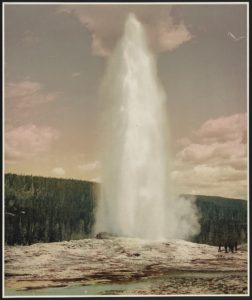Why have National Parks?
Subject(s): Geography and US History
Time Period(s): (1890-1930) Emergence of Modern America, (1929-1945) Great Depression and World War II, (1945-Early 1970s) Postwar United States, and (1968 to the Present) Contemporary United States
Grade level(s): 3-5
Click here to download the powerpoint
Supporting question(s):
Why are some places national parks, and others are national historic sites?
Why do you think the places in these documents became part of the national park system?
What important events took place at these sites?
Are national parks important to Americans? Why or why not?
What types of landforms, vegetation, and wildlife are present in each place?
Source Set
- Old Faithful, Yellowstone National Park, Wyoming
- Mount Rushmore, South Dakota
- Pennsylvania. Independence Hall Exterior.
- The Entrance to the Government Reservation, Hot Springs
- Hot Springs National Park
- Grand Canyon National Park
- Statue of Liberty and Ellis Island
Description
The photograph, taken between 1920 and 1950, shows the outside of Independence Hall in Philadelphia, with trees and a statue.
Description
Picture of the old entrance to the Government Reservation (National Park), Hot Springs, Arkansas, taken between 1896 and 1901.
Description
This booklet is a tourist guide to Hot Springs National Park written in 1919. It contains maps, photographs, lists of the bathhouses, and descriptions of other attractions.
Description
Statue of Liberty view is from ground level and Ellis Island is viewed from above. Includes text, location map showing ferry connections, 2 illustrated timelines and illustrations depicting the history of the area.
Additional resource(s):
Database of places in the National Park Service
National Geographic Kids: History of the National Parks
Arkansas Frameworks(s):
H.12.3.5 Analyze relationships of national symbols, holidays, and historic places (e.g., Liberty Bell, Fourth of July, Daisy Bates Day, Little Rock Nine, Central High School)
H.12.4.5 Reference historic places and national parks to guide inquiry about history (e.g., What do the Toltec Mounds tell us about the people who lived there?)







